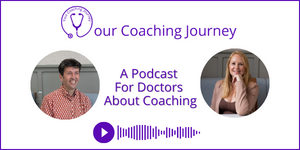We love that coaching helps our coachees to generate new thinking. If you’re self-aware as a coach and continue to engage in reflective practice your coaching conversations are going to help you to develop your own thinking too.
But what happens when your unconscious thought processes start to get in the way of your own performance in the coaching room, and your coachee’s unconscious prohibits their ability to think through their situation in an open and expansive way.
In a recent podcast episode we explored unconscious bias and how the phenomenon might impact us as coaches, as well as limiting our coachee’s ability to do some really good thinking. The problem with unconscious biases is that we don’t know we have them, even though we recognise that other people are subject to them; a phenomenon known as the bias blindspot.
We believe that unconscious bias is a fascinating subject to shine a light on and to identify some rather interesting specific biases. So, we’ll be doing a little bit of that as well as exploring how we, as coaches, can remain open to the possibility of us bringing our own biases into the coaching room. We’ll also discuss how you are able to introduce the idea of unconscious bias to your coachees, allowing them to consciously bring some of their own biases to light and start to unpick them. Awareness is the first step to being able to mindfully dispel some of our more unhelpful unconscious thinking.
We hope you enjoy the conversation and that it starts your own journey of self-discovery around your unconscious biases.
What Is Unconscious Bias?
Unconscious bias refers to the automatic judgments we make based on stereotypes, beliefs, or personal feelings rather than objective evidence. They can be thought of as a “brain shortcut”.
Why Do We Have Unconscious Biases?
Unconscious biases exist because they simplify our complex world. Our brains act as “cognitive misers,” conserving energy by creating schemas—mental shortcuts based on prior knowledge and experiences. This mechanism allows us to process information quickly. While these shortcuts may save cognitive energy, they can lead to overgeneralisations stereotypes, and problematic judgments and behaviours.
Examples of Unconscious Bias
- Blind Spot Bias: A common tendency where people recognise biases in others but fail to see their own. It’s the ultimate irony—believing, “Everyone else has biases, but not me.”
- Confirmation Bias: The propensity to seek out information that supports our pre-existing beliefs while ignoring evidence that contradicts them.
- Halo and Horn Effects: These biases occur when we allow one positive or negative trait to shape our entire view of a person. The halo effect leads us to see someone as universally good because of one admirable quality, while the horn effect does the opposite, amplifying their perceived flaws.
- Optimism Bias: A cognitive illusion where people believe they are better than average at certain tasks or immune to negative outcomes. While this bias may reflect humanity’s hopeful nature, it often leads to unrealistic expectations
- The IKEA Effect: This modern bias reflects our tendency to overvalue things we’ve had a hand in creating. From assembling furniture to completing a project, personal investment inflates perceived worth.
Biases in Organisations and Society
Unconscious biases aren’t limited to individual interactions—they also shape workplace cultures, hiring practices, and broader societal norms.
- Gender and Racial Biases: Despite progress in awareness, these biases persist in hiring processes and workplace dynamics. Often “like hires like” in unconscious decision-making.
- Intersectionality: When biases intersect, such as race and gender, they compound disadvantages. For example, studies have shown that Black women in academia face disproportionately low pay compared to other groups.
- Dignity and Respect in the Workplace: Biases can show up in subtle ways, like “he-peating,” where women’s ideas are ignored until repeated by men. Awareness and proactive strategies, like amplifying others’ voices, can help counteract these tendencies.
Biases in the Coaching Room
Coaching, like any other human interaction, is susceptible to unconscious bias. Some of the biases that may appear include:
- Optimism Bias: Clients and coaches alike may overestimate their abilities, such as listening skills, only to discover room for improvement through practice.
- The Sunk Cost Fallacy: A reluctance to abandon a course of action despite negative outcomes because of the resources already invested.
- The Semmelweis Reflex: A rejection of new evidence that contradicts established beliefs. This bias takes its name from Ignaz Semmelweis, a physician who faced decades of resistance to his lifesaving handwashing practices in the 19th century.
- Anchoring Effect: The influence of initial information on subsequent judgments, such as pricing a product based on a previously mentioned number.
Overcoming Unconscious Bias
Recognizing and addressing unconscious bias requires self-awareness and intentional effort. Awareness is the first step toward mitigating the effects of bias, whether in personal decision-making, coaching, or organisational policies.
Practical strategies include:
- Education: Workshops and training can help individuals understand their biases and learn techniques to counteract them.
- Mindful Reflection: Taking time to question assumptions and seek alternative perspectives can interrupt automatic judgments.
- Amplification and Advocacy: Proactively crediting and supporting underrepresented voices ensures inclusivity and counters biases like “he-peating.”
A Final Thought
Unconscious bias is an inescapable part of being human. However, by acknowledging its existence and striving to understand its impact, we can reduce its influence and create fairer, more inclusive environments. It can also help encourage broader and deeper thinking with fewer assumptions made during the coaching process. Who knows what we might consider as possible if we can turn off some of our unconscious shortcuts.
To find out more about our Doctors’ Transformational Coaching Diploma click through here



